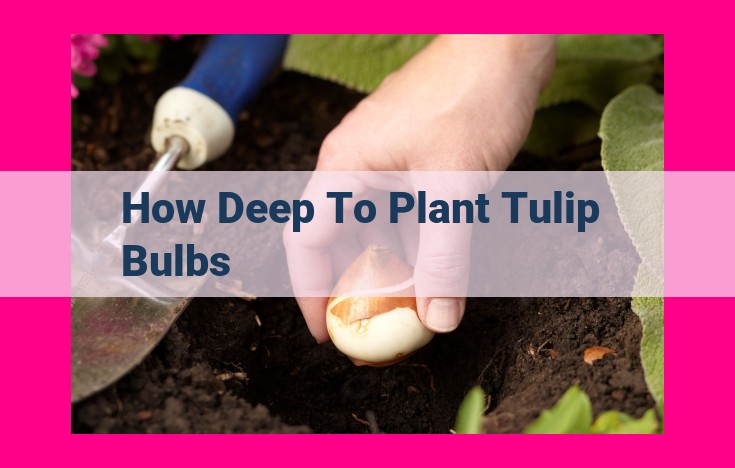Essential Guide To Planting Tulips: Depth, Structure, And Soil Considerations

To ensure healthy tulip growth, plant bulbs deeply, approximately 6-8 inches below the soil’s surface. This depth allows the bulb to develop a strong root system that anchors the plant and draws moisture and nutrients from the soil. Consider the bulb’s structure, with the pointed end facing up to facilitate stem and leaf growth. Amend the soil with organic matter or bulb fertilizer to enhance drainage and provide additional nutrients.
Essential Bulb Properties for Success: A Guide to Healthy Tulips
When it comes to gardening, tulip bulbs are a true delight, adorning our landscapes with vibrant hues and captivating blooms. To ensure their success, it’s crucial to understand the essential properties of healthy bulbs and their structure.
Characteristics of Healthy Tulip Bulbs
Healthy tulip bulbs are firm, plump, and free of any cuts, bruises, or blemishes. They should have a brown or tan outer skin that is not dry or cracked. Avoid any bulbs that appear soft, shriveled, or moldy.
Structure of a Tulip Bulb
The structure of a tulip bulb is fascinating and intricate. At the base lies the root system, a network of fibrous roots that anchors the bulb and absorbs nutrients from the soil. Above this, we find the basal plate, a flattened disc that supports the bulb’s layers.
Within the bulb, there are concentric layers of fleshy scales. These scales store energy and nutrients, providing nourishment for the developing plant. At the heart of the bulb lies the embryonic shoot, a tiny miniature version of the tulip plant that will eventually emerge from the soil.
By understanding these essential properties and structure, we can choose healthy tulip bulbs that will thrive in our gardens, bringing us seasons of breathtaking beauty.
Optimal Planting Parameters for Thriving Tulips
To ensure your tulips flourish in their new home, meticulous attention to planting parameters is crucial. Let’s delve into the specifics that will lay the foundation for their vibrant blooms:
Ideal Planting Depth
The depth at which you plant your tulip bulbs significantly impacts their development. As a general rule, they should be planted at a depth that is twice the height of the bulb. For instance, if your bulb measures 2 inches tall, plant it 4 inches deep. This depth provides ample space for the bulb to establish its root system and access essential nutrients from the soil.
Optimal Soil Conditions
Tulip bulbs thrive in well-drained soil that is rich in organic matter. Amend the soil with compost or manure to enhance its fertility and drainage capacity. The ideal soil pH for tulips ranges from 6.0 to 7.0. If your soil falls outside this range, consider adding lime or sulfur to adjust its acidity or alkalinity.
Use of Trowel and Soil Amendment
When planting tulip bulbs, use a trowel to create a hole large enough to accommodate the bulb comfortably. Gently place the bulb in the hole with its pointed end facing up. Backfill the hole with amended soil and gently firm it around the bulb. This careful handling ensures optimal positioning and prevents damage to the delicate root system.
Benefits of Mulching
Mulching around tulip plants offers a multitude of benefits. A layer of mulch helps retain moisture, preventing the soil from drying out quickly, especially during hot, dry weather. It also suppresses weeds, reducing competition for water and nutrients. Additionally, mulch insulates the soil, protecting the bulbs from extreme cold or heat and promoting healthy growth.
Environmental Considerations for Thriving Tulips
Climate Zones and Soil Temperature
When selecting tulips for your garden, it’s crucial to consider your climate zone. Different tulip varieties prefer specific temperature ranges. For instance, early-flowering tulips thrive in cooler zones, while late-blooming varieties prefer warmer climates.
To ensure optimal growth, plant tulips in soil that reaches the appropriate temperature for their type. Early-flowering tulips prefer soil temperatures between 35-45°F (2-7°C) at planting time. Mid-season tulips thrive in slightly warmer soil, around 40-50°F (4-10°C), while late-flowering tulips prefer warmer soil temperatures of 50-60°F (10-16°C).
Sunlight Exposure
Tulips are sun-loving plants that require ample sunlight to produce vibrant blooms. Aim for a location with at least six hours of direct sunlight each day. If your garden has limited sunlight, choose tulip varieties known for tolerating partial shade, such as ‘Ballade’ or ‘Negrita’.
Remember, these environmental factors play a pivotal role in the success of your tulip plants. By carefully considering your climate zone, soil temperature, and sunlight exposure, you can create the perfect conditions for your tulips to flourish and bring color and joy to your garden.